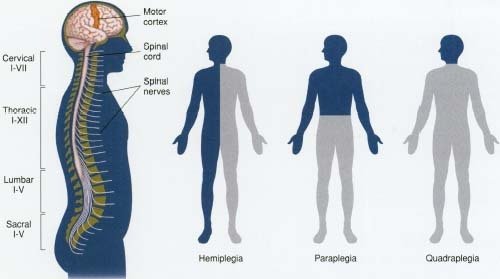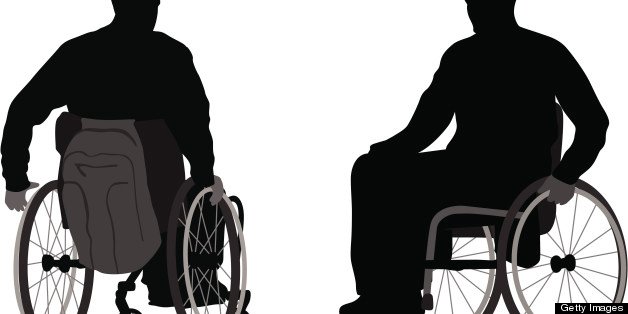Types of Paralysis
here are many types of paralysis because there are innumerable ways that the body can be injured, though paralysis is typically divided into four categories.
In childhood, you probably learned that paralysis means the complete inability to move, to sense touch, or to control bodily sensations. As with most things we learn as children, the real meaning of paralysis is actually significantly more nuanced. Paralysis comes in many forms, and the extent to which a person is immobilized my change over time as physical therapy, changes in health, and sheer luck alter the way the body responds to physical damage.

What is Paralysis?
Paralysis is the inability—whether temporary or permanent—to move a part of the body. In almost all cases, paralysis is due to nerve damage, not to an injury to the affected region. For instance, an injury in the middle or lower regions of the spinal cord is likely to disrupt function below the injury, including the ability to move the feet or feel sensations, even though the actual structures are as healthy as ever. So what happens to the body when it is paralyzed? That depends on the cause of the paralysis, but generally at least one of the following factors is in play:
- The brain is unable to relay a signal to an area of the body due to injuries to the brain.
- The brain is able to sense touch and other sensations in the body, but is unable to effectively relay a response due to injuries in the spinal cord.
- The brain can neither send nor receive signals to an area of the body due to injuries in the spinal cord.
The spinal cord is like the brain's relay system, so when something in the spinal cord doesn't work or is injured, paralysis is often the result. These injuries can be the product of traumatic accidents, or diseases such as strokes and polio. Most spinal cord injuries are incomplete, which means that some signals still travel up and down the cord. With an incomplete injury, you may retain some sensation and movement all the time, or the severity of the paralysis may change—sometimes on a highly unpredictable basis. A complete spinal cord injury, by contrast, completely compressed or severs the nerves in the spinal cord, making it impossible for the signal to travel. Rarely, injuries to the affected area cause paralysis. This is more common among people who have another medical condition, such as diabetes. For instance, diabetic nerve damage can cause nerves in some area of the body, particularly the feet, to cease functioning. You'll still be able to move, but you might have reduced or little sensation. This can result in more laborious movements, a loss or decrease in your ability to walk, and an increased risk in some other health issues, such as cardiovascular episodes.
What Causes Paralysis?
Strokes are the most common cause of paralysis because of their ability to injure the brain and impede its relationship with the spinal cord. They account for 29% of all paralysis cases.Spinal cord injuries account for 23% of paralysis cases, with car accidents, falls, sporting injuries, and act of interpersonal violence causing most spinal cord injuries. Other common causes of paralysis include:
- Multiple sclerosis (17%)
- Cerebral palsy (7%)
- Post-polio syndrome (5%)
- Traumatic brain injury (4%)
- Neurofibromatosis (4%)
- Birth defects (2%)
Types of Paralysis
In reality, there are many types of paralysis because there are innumerable ways that the body can be injured. There are four main categories of paralysis, however, which have to do with the portion of the body that is affected.
Monoplegia
Monoplegia is paralysis of a single area of the body, most typically one limb. People with monoplegia typically retain control over the rest of their body, but cannot move or feel sensations in the affected limb. Though cerebral palsy is the leading cause of monoplegia, a number of other injuries and ailments can lead to this form of partial paralysis, including:
- Strokes
- Tumors
- Nerve damage due to injuries or diseases
- Nerve impingement
- Motor neuron damage
- Brain injuries
- Impacted or severed nerves at the affected location
Monoplegia is sometimes a temporary condition, and is especially common in the aftermath of a stroke or brain injury. When the nerves affecting the paralyzed area are not fully severed, it is often possible to regain significant function through physical therapy. Learn more about monoplegia.
Hemiplegia
Hemiplegia affects an arm and a leg on the same side of the body, and as with monoplegia, the most common cause is cerebral palsy. With hemiplegia, the degree of paralysis varies from person to person, and may change over time. Hemiplegia often begins with a sensation of pins and needles, progresses to muscle weakness, and escalates to complete paralysis. However, many people with hemiplegia find that their degree of functioning varies from day to day, and depending on their overall health, activity level, and other factors. Hemiplegia should not be confused with hemiparesis, which refers to weakness on one side of the body. Nevertheless, hemiparesis is often a precursor to hemiplegia, particularly for people with neurological issues. Hemiplegia is sometimes temporary, and the overall prognosis depends on treatment, including early interventions such as physical and occupational therapy. Read more about hemiplegia.
Paraplegia
Paraplegia refers to paralysis below the waist, and usually affects both legs, the hips, and other functions, such as sexuality and elimination. Though stereotypes of paraplegia hold that people with this condition cannot walk, move their legs, or feel anything below the waist, the reality of paraplegia varies from person to person—and sometimes, from day to day. Thus paraplegia refers to substantial impairment in functioning and movement, not necessarily a permanent and total paralysis. Rarely, people with paraplegia spontaneously recover. This may be due to brain or spinal cord functions that are not yet understood, such as regeneration of neurons. More typically, paraplegics are able to regain some functioning with physical therapy, which works to retrain the brain and spinal cord to work around limitations while strengthening muscles and nerve connections. Spinal cord injuries are the most common cause of paraplegia. These injuries impede the brain's ability to send and receive signals below the site of the injury. Some other causes include:
- Spinal cord infections
- Spinal cord lesions
- Brain tumors
- Brain infections
- Rarely, nerve damage at the hips or waist; this more typically causes some variety of monoplegia or hemiplegia.
- Brain or spinal cord oxygen deprivation due to choking, surgical accidents, violence, and similar causes.
- Stroke
- Congenital malformations in the brain or spinal cord
Read more about paraplegia.

Quadriplegia
Quadriplegia, which is often referred to as tetraplegia, is paralysis below the neck. All four limbs, as well as the torso, are typically affected. As with paraplegia, though, the degree of disability and loss of function may vary from person to person, and even from moment to moment. Likewise, some quadriplegics spontaneously regain some or all functioning, while others slowly retrain their brains and bodies through dedicated physical therapy and exercise. Occasionally, quadriplegia is a temporary condition due to brain injuries, stroke, or temporary compression of spinal cord nerves. Some spinal cord injury survivors temporarily suffer from quadriplegia immediately after the injury, then experience a less systematic form of paralysis as swelling goes down, the nerves become less compressed, or surgery reverses some damage. As with paraplegia, spinal cord injuries are the leading cause of quadriplegia. The most common causes of spinal cord injuries include automobile accidents, acts of violence, falls, and sporting injuries, especially injuries due to contact sports such as football. Traumatic brain injuries can also cause this form of paralysis. Other sources of quadriplegia include:
- Acquired brain injuries due to infections, stroke, and other disease-related processes.
- Loss of oxygen to the brain and spinal cord due to choking, anesthesia-related accidents, anaphylactic shock, and some other causes.
- Spinal and brain lesions
- Spinal and brain tumors
- Spinal and brain infections
- Catastrophic nerve damage throughout the body
- Congenital abnormalities
- Early brain injuries, especially pre-birth or during-birth injuries that lead to cerebral palsy, which can produce a range of symptoms, including varying degrees of paralysis
- Allergic reactions to drugs
- Drug or alcohol overdoses
with thanks: http://www.spinalcord.com/types-of-paralysis